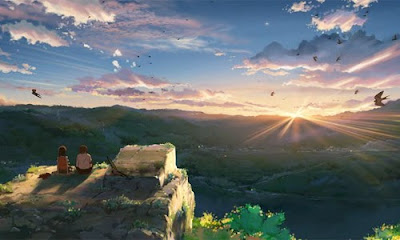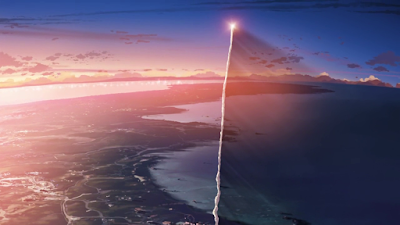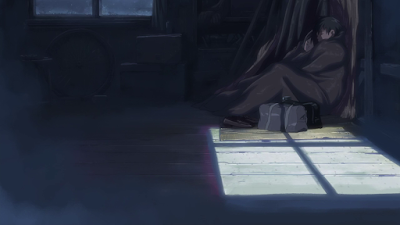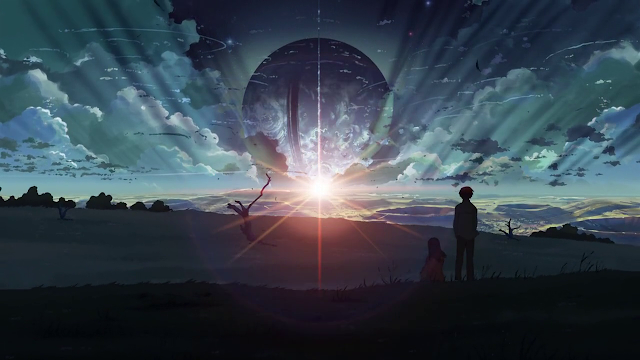During New York Comic Con 2011 I had the privilege to sit down with Makoto Shinkai; director of Voices of a Distant Star, 5 Centimeters Per Second , and his newest work Children Who Chase Lost Voices from Deep Below. This interview took place, unfortunately, before the screening of his new film so my questions focus on his previous work.
We start by talking about some of the influences and themes of Children Who Chase Lost Voices from Deep Below, then I transition into some specifics about the creation of 5 Centimeters Per Second and the upcoming manga that Kodansha is bringing to the US market. We end the interview by asking about his attention to background detail, his thoughts on the state of the Anime industry, and his advice for upcoming Anime creators.
My questions are indicated with “Otaku in Review” and the other interviewers present are indicated simply by “Press.”
We began the interview by introducing ourselves to Shinkai-San. He then humbly introduced himself to us:
Makoto Shinkai: I’m Makoto Shinkai. I’m a director. 5 Centimeters per Second is, I think, my main title.
Otaku in Reivew: So you think 5 Centimeters Per Second is your greatest work?
MS: Many people say so but it’s been four years since its release and I’d like more people to pay more attention to Children Who Chase Lost Voices From Deep Below. The two titles are completely separate they have different styles and topics so some like one over the other.
OiR: Unfortunately I haven’t seen the new film yet, I will be at the screening tomorrow. Reviewers have compared the styling to Studio Ghibli, is there any influence?
MS: There is no Japanese Animation creator who hasn’t been influenced by Studio Ghibli. That’s the atmosphere that we live in.
Press: What is your influence? Is there anything in your past that influences your work?
MS: During University days I was studying Modern Japanese Literature and I am a big Haruki Murakami fan. I think that influenced my storytelling a lot because I read his novels over and over again.
OiR: The theme of your first three works seems to be “relationships through distance and time,” why does this theme resonate with you?
MS: When I was making those three films I was thinking a lot about human relationships and at the same time new technology was coming into play. Human relationships and how people communicate was a theme I was thinking about a lot so when I made Voices of a Distant Star that was when people were just starting to use Cell Phones in Japan a lot and they were sending mail, short messages, and because of that technology sometimes a message would come five minutes later, two hours later, or maybe in a day or even, in the case of Voices, like a few years later. I was thinking of the way new technology effects the way relationships develop.
 Press: I’d like to ask you to talk about Children Who Chase Lost Voices From Deep Below. What was your underlying theme for this film? Was it also a study in human relationships and how people communicate?
Press: I’d like to ask you to talk about Children Who Chase Lost Voices From Deep Below. What was your underlying theme for this film? Was it also a study in human relationships and how people communicate?
MS: The biggest difference is that this is also about human relationships, how people relate to each other, but this time it’s about the relationship between a living person and a person who has already passed away. That’s the biggest difference. It’s still about human relationships but this one is about the relationship with someone who has already passed on.
OiR: I have a couple about 5 Centimeters because I have yet to see the new film. Masayoshi Yamazaki’s “One more time, one more chance” plays a prominent role in the ending of 5 Centimeters Per Second. How did it play in the creation of the film?
MS: We made 5 Centimeters I wasn’t planning on creating a new song to match with the story. I was telling a story that happened in the 90s so I looked at a bunch of pop songs that happened in that era. When I heard Masayoshi’s “One more time, One more chance” I thought it fit the story perfectly and it was extremely popular when it was released so everyone was familiar with it.
OiR: At the beginning of Episode 2 of 5 Centimeters Per Second there is a magnificent image of the sun rising behind the earth. (image above) Can you talk about creating that image?
MS: Takaki, the male character, had dreams of this girl he liked who was very far away. In the image they’re both on a distant planet that is far away, so he’s dreaming that he’s with her even though she’s in a far away place. That image came from something a bit different. When I was in High School I had a recurring dream where I became lost on a faraway star.
When I was in high school I was really into Science Fiction and I used to read a monthly magazine called “Newton,” a science magazine. Today the images in science magazines are computer generated but at that time they were hand drawn and I thought they were really cool. So I was thinking about those a lot and had those dreams.
OiR: The 5 Centimeters Per Second Manga will be coming to the US soon. How do the manga and the film pair with each other? 
MS: Normally in Japan there is a manga first and it gets popular, sells millions of copies, and then they make the anime. The story behind the 5 Centimeter manga is like this: First when I came up with the story I made the anime. Then after I made an anime there were a lot of things I wanted to improve on so I wrote a short novel and in it I fixed the elements that I thought were weak in the anime. Shortly afterwards I was approached by Kodansha and they asked if they could make a manga out of the short novel. The manga is actually a culmination of both the anime and the short novel so I believe it’s the best representation of the work I wanted to make. It mixes the best elements of the anime with the best elements of the short novel together. I recommend people check it out.
Press: I’d like to ask your opinion on the Japanese animation industry in general. What’s your opinion on the recent trends and the thematic elements used in recent anime?
MS: Right now in Japan there is a lot of anime being made for lots of different tastes and that’s a good thing. There are new styles of anime, for example the noitamina slot on Fuji TV. Noitamina is animation spelled backwards so they take anime and they try new things all the time. I don’t know if this works economically and I don’t watch much anime myself, but I know what’s going on. In the old days the anime was very similar and everything was typical so I think the new varieties of anime is healthy for the industry. However, in the long term it’s a question mark as where 2D animation is going in Japan. As we see in the United States 3D is taking over and becoming more popular. I think that will eventually happen in Japan as well which means that what we know as anime today may go away because of 3D coming in and because there are less and less people who can actually make anime these days. That’s a little bit sad but it’s just evolution and it’s the way things should evolve in the future.
 Otaku in Review: In the last ten or fifteen years the people who do background animation are retiring or leaving the industry. Yet you focus a lot on background detail and the tiny elements in a scene. Such as She and Her Cat which is compact and beautiful and yet is filled with vibrant detail, even small elements like the kitchen. Why are those backgrounds so important?
Otaku in Review: In the last ten or fifteen years the people who do background animation are retiring or leaving the industry. Yet you focus a lot on background detail and the tiny elements in a scene. Such as She and Her Cat which is compact and beautiful and yet is filled with vibrant detail, even small elements like the kitchen. Why are those backgrounds so important?
MS: When I made She and Her Cat I was working on a Fantasy Role Playing Game during the day. In a fantasy role playing game your surroundings are very rich and detailed. But I was living in a typical small Japanese apartment and around the apartment building were concrete telephone poles with lots of electric wires. That’s a typical kind of surroundings we have while living in a very small place. Even though the surroundings may be jumbled with ugly things I wanted to find the beauty in the things all around me. Even living in a small apartment surrounded by electrical lines I wanted to make it look detailed and beautiful to express that it was ok to live in such a situation. That’s why I believe I focus on all these background details.
OiR: Has your time in England inspired your work at all?
MS: I lived in London for a year and for the first six months I was going an English school, even though I was thirty-five years old I was going to school with a bunch of college kids. The next sixth months I spent working the script for Children Who Chase Lost Voices from Deep Below. During that time I was able to visit all the museums, I especially enjoyed the British Museum of Art and the World History Museum where they had ancient artifacts. When you see the film you’ll see ruins of ancient societies so going to museums influenced me that way. But when you watch the film you won’t think it has a British influence, while I was in London I was able to explore some global things. 
OiR: For upcoming animation directors do you recommend the independent route or should they go the classic route, start at Key Animation and climb up the ladder while working in the industry.
MS: It’s difficult to suggest the best way right now because there are no barriers to entry. If you’re an artist and want to create something and put it on the internet and everybody can see it. But there are some demerits for that because you feel like your job is done, you’ve shown everyone your work. It’s different from the old days where you’d make something and take it to a publisher to see if they’d publish it. They’d be a lot of back and forth and negotiations required to get your work out. In that sense it’s good so you can get your work out quickly but it’s also still good to work for a studio and climb the ladder that way because in the old days you’d have had to brush up your work before it went out into the public. You had to work hard before you could show it to the public. Now it’s so easy you don’t even have to work too hard.
Maybe the best was it to make the best possible thing by yourself and get it out there and then from there it’ll make it easier to talk with studios and then you can enter a professional studio and work on things. Maybe that’s the best way
I’d like to thank Makoto Shinkai for taking the time to sit down with me during his busy trip to New York. I’d also like to thank Crunchyroll’s Vincent Shortino for helping bring Shinkai-San to New York Comic Con and for help with translation.
Also check out video of Makoto Shinkai opening and closing the screening of Children Who Chase Lost Voices from Deep Below and the Makoto Shinkai panel.
Screenshots from Children Who Chase Lost Voices from Deep Below taken from Manga Market.

Excellent interview!For someone who's being hailed as the next Miyazaki, he seems awfully humble. Huge fan of his works. Would've liked more insight into the Japanese anime industry, but this is still a great read. Thanks!
LikeLike